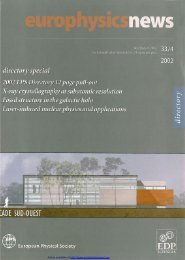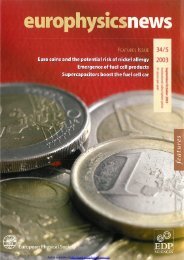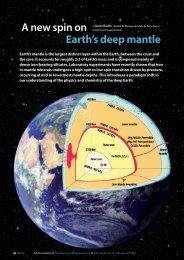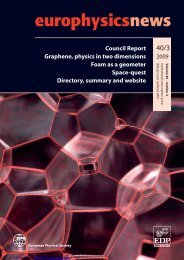Whole issue in PDF - Europhysics News
Whole issue in PDF - Europhysics News
Whole issue in PDF - Europhysics News
Create successful ePaper yourself
Turn your PDF publications into a flip-book with our unique Google optimized e-Paper software.
FEATURES<br />
and the easy observation of <strong>in</strong>homogeneities <strong>in</strong> the optical phase<br />
ofthe outgo<strong>in</strong>g beam on the other hand.<br />
X-ray scann<strong>in</strong>g imag<strong>in</strong>g<br />
The X-ray beams produced by undulators at third generation SR<br />
soUrces can, because they orig<strong>in</strong>ate. <strong>in</strong> a very small source, be<br />
focused <strong>in</strong>to a very f<strong>in</strong>e spot (on the order ofa micrometer <strong>in</strong> l<strong>in</strong>ear<br />
size) with extremely high <strong>in</strong>tensity. It is then possible to scan<br />
the sample with respect to the beam, with an appropriate detector<br />
or bank of detectors collect<strong>in</strong>g quantitative <strong>in</strong>formation. This<br />
<strong>in</strong>formation is then displayed on an electronic device as a po<strong>in</strong>t<br />
with variable <strong>in</strong>tensity and colour at the coord<strong>in</strong>ates correspond<strong>in</strong>g<br />
to the position ofthe beam. This provides the exact analogue<br />
of scann<strong>in</strong>g electron microscopy. There is a wide variety <strong>in</strong> the<br />
type of <strong>in</strong>formation available: wide angle diffracted X-rays, or<br />
small-angle scattered X-rays, fluorescence photons, or secondary<br />
electrons. A whole range of scann<strong>in</strong>g X-ray imag<strong>in</strong>g techniques<br />
appeared, and they will certa<strong>in</strong>ly develop brilliantly over the next<br />
few years.<br />
Why phase?<br />
A beam of X-rays go<strong>in</strong>g through an object suffers; apart from<br />
absorption, a phase shift, because the refractive <strong>in</strong>dex ofmaterials<br />
is slightly different from unity. The complex refractive <strong>in</strong>dex<br />
n =1 - 8 + i f3 describes both absorption (related to f3) and the<br />
phase shift with respect to the beam <strong>in</strong>vacuum:<br />
In practice, obta<strong>in</strong><strong>in</strong>g a phase-sensitive image just <strong>in</strong>volves sett<strong>in</strong>g<br />
the detector (film or CCD camera) at a distance D on the<br />
order of one tenth of a meter from the sample. An absorption<br />
image is obta<strong>in</strong>ed ifD is small (mm range). This corresponds to<br />
the fact that the region <strong>in</strong> the sample that affects the image at a<br />
po<strong>in</strong>t of the detector has a size r ="(AD) , the radius ofthe first<br />
Fresnel zone. When D is a few mm, the size ofthis zone is below<br />
the resolution of the detector (J.1m), and no <strong>in</strong>terference will be<br />
observed: onlyabsorption contrastwillbe effective. For largervalues<br />
ofD, but with r rema<strong>in</strong><strong>in</strong>g small with respect to the size a of<br />
the object to be imaged, the edges ofthe object behave <strong>in</strong>dependently,<br />
and are the only contribution to the image. The best<br />
sensitivity to a phase object ofsize a is obta<strong>in</strong>edfor a distance D =<br />
a 2 /2A, butthen the image is a hologramwhich does notlookmuch<br />
like the object.<br />
The major advantage ofthis new type ofimag<strong>in</strong>g is the <strong>in</strong>creased<br />
sensitivity it provides. Fig. 4 shows, for alum<strong>in</strong>ium, that 8» f3 <strong>in</strong><br />
the hardX-ray range (B > 6 keV). This expla<strong>in</strong>s the ga<strong>in</strong> observed,<br />
particularly for light materials such as polymers, or for composites<br />
consist<strong>in</strong>g ofmaterials which equally attenuate X-rays, such as<br />
AlandSiC.<br />
The phase variations across the beam at the sample exit<br />
lead to variations <strong>in</strong> <strong>in</strong>tensity, hence to contrast, provided<br />
the phase has a non-vanish<strong>in</strong>g two-dimensional Laplacian,<br />
{()2cp/aXJ-) + (()2cp/ar) "# O. They show up, for <strong>in</strong>creas<strong>in</strong>g values of<br />
D, through the appearance of a black-white l<strong>in</strong>e at the phase<br />
q; (x, y) =- (2n/A-) f8(x,y, z) dz<br />
where the <strong>in</strong>tegral is taken along the path ofthe beam. This phase<br />
is non-uniform over a cross-section of the X-ray beam if the<br />
thickness and/or the structure ofthe sample are <strong>in</strong>homogeneous.<br />
8 is proportional to the electronic density of the material, hence<br />
approximately to its mass density; it must be corrected for dispersion<br />
when the photon energy is near an absorption edge. The<br />
phase cannotbe measured directly, andvariations <strong>in</strong> phase do not<br />
affect the <strong>in</strong>tensityofthe beam as it exits the sample. Phase images<br />
have been obta<strong>in</strong>ed, us<strong>in</strong>g laboratory sources or second generation<br />
synchrotron radiation, us<strong>in</strong>g elaborate devices<br />
(<strong>in</strong>terferometers, many-crystal setups). With many images ofthe<br />
sample recordedwhile it is rotated <strong>in</strong> an <strong>in</strong>terferometer, it is possible<br />
to reconstruct <strong>in</strong> 3D the distribution ofrefractive <strong>in</strong>dex, i.e. to<br />
perform phase tomography.<br />
The qualitativelynew character ofthird generation SR is thatits<br />
lateral coherence makes it possible to visualise and reconstruct<br />
the phase variations of hard X-rays, both <strong>in</strong> simple radiography<br />
and <strong>in</strong> tomography, with great <strong>in</strong>strumental simplicity. Furthermore,<br />
better spatial resolution can be reached compared to<br />
exist<strong>in</strong>g phase imag<strong>in</strong>g techniques. The required coherence is<br />
obta<strong>in</strong>ed thanks to the very small angular size a ofthe source as<br />
seen by a po<strong>in</strong>t <strong>in</strong> the sample (less than a microradian on the<br />
imag<strong>in</strong>g beaml<strong>in</strong>e ID19), which entails a large lateral coherence Le<br />
ofthe X-ray beam, with wavelength A.:<br />
For example, Le = 100 J.1m for A- =1 A. In optical terms, the effect<br />
used to turn local variations of phase <strong>in</strong>to <strong>in</strong>tensity variations is<br />
<strong>in</strong>terference, at f<strong>in</strong>ite distance, between parts of the beam that<br />
have suffered different phase shifts but are coherent with one<br />
another. This is the analogue of defocus<strong>in</strong>g <strong>in</strong> electron<br />
microscopy: it can be described <strong>in</strong> terms ofFresnel diffraction, or<br />
of<strong>in</strong>-l<strong>in</strong>e holography.<br />
europhysics news MARCH/APRIL 2001<br />
Fig. 6: a) Scann<strong>in</strong>g electron microscope image of the<br />
surface of a composite material consist<strong>in</strong>g of an alum<strong>in</strong>ium<br />
matrix re<strong>in</strong>forced by SiC particles b)-e) Slices obta<strong>in</strong>ed by<br />
. computed tomography correspond<strong>in</strong>g to zones<br />
respectively at the surface, and 25 Ilm,50 Ilm and 75 Ilm<br />
below the surface. The sample suffered a monotonic tensile<br />
test of 1%. Cracked SiC particles can be detected (arrows A<br />
and B), as well as a crack <strong>in</strong> the alum<strong>in</strong>ium matrix (arrow Cl.<br />
The tomographic acquisition was performed at an X-ray<br />
energy of 25 keY and a sample-detector distance of 0.82 m<br />
(collaboration with J.-Y. Buffiere,INSA, Lyon).<br />
49










